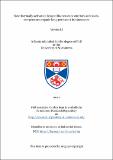New thermally activated delayed fluorescence emitters and room-temperature organic long-persistent luminescence
Abstract
Organic light-emitting diodes (OLEDs) have attracted a lot of attentions because of their high performance in display applications. Organic emitters are still being developed to improve efficiency, colour gamut and sustainability, and thermally activated delayed fluorescence (TADF) materials are widely regarded as one of the most promising next-generation OLED emitters. To date, green TADF emitters have been developed, and the corresponding OLEDs show high light-emitting efficiency and long operation lifetimes. However, the performance of red and blue TADF OLEDs still lag their green-emitting counterparts. For this reason, this work focuses on developing new red and deep-blue TADF materials. A group of red and blue TADF emitters were designed and synthesized. Their photophysical properties and electroluminescence performance were also studied. In addition, it was found that doping some of these new emitters into common host materials, such as 2,8-bis(diphenyl-phosphoryl)dibenzo[b,d]thiophene (PPT), 2,2',2"-(1,3,5-Benzinetriyl)-tris(1-phenyl-1-H-benzimidazole) (TPBi) or poly(methyl methacrylate) (PMMA), can lead to organic long-persistent luminescence (OLPL) lasting for thousands of seconds at room temperature. As traditional room-temperature OLPL materials are based on exciplex emitters, the new OLPL systems discovered here demonstrates that exciplex formation is not required for harvesting OLPL. This enables a wide range of host materials to be used including materials as simple as PMMA. Expanding this concept further, the author developed a method for large-scale PMMA-based OLPL sample fabrication to take full advantage of its low expense. This method gives thick (> 2 mm) and clear OLPL products, and all the required equipment is easily accessed in lab condition. Combining the flexible design of TADF emitters and mature PMMA industry, this work opens the ‘door’ of large-scale, colour tuneable and cost-efficient room-temperature OLPL materials. At the same time, the light-emitting properties and mechanism of these new OLPL emitters were studied, which provides a guideline for further OLPL emitter improvements.
Type
Thesis, PhD Doctor of Philosophy
Rights
Embargo Reason: Embargo period has ended, thesis made available in accordance with University regulations
Collections
Description of related resources
Data underpinning Wenbo Li's thesis. Li, W., University of St Andrews. DOI: https://doi.org/10.17630/24c82e40-099d-4bbd-9a3d-6f76a1c7593cRelated resources
https://doi.org/10.17630/24c82e40-099d-4bbd-9a3d-6f76a1c7593cItems in the St Andrews Research Repository are protected by copyright, with all rights reserved, unless otherwise indicated.

